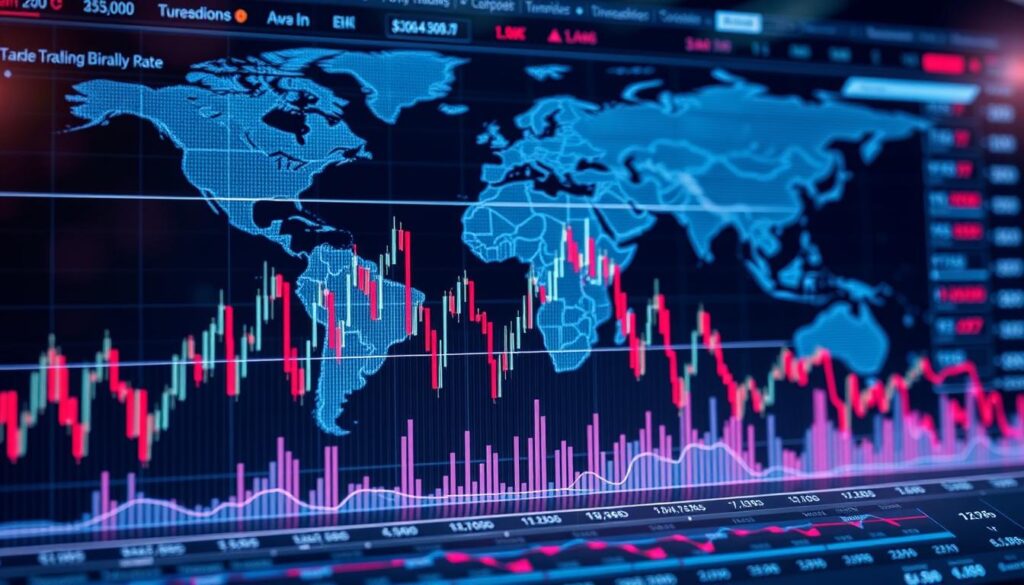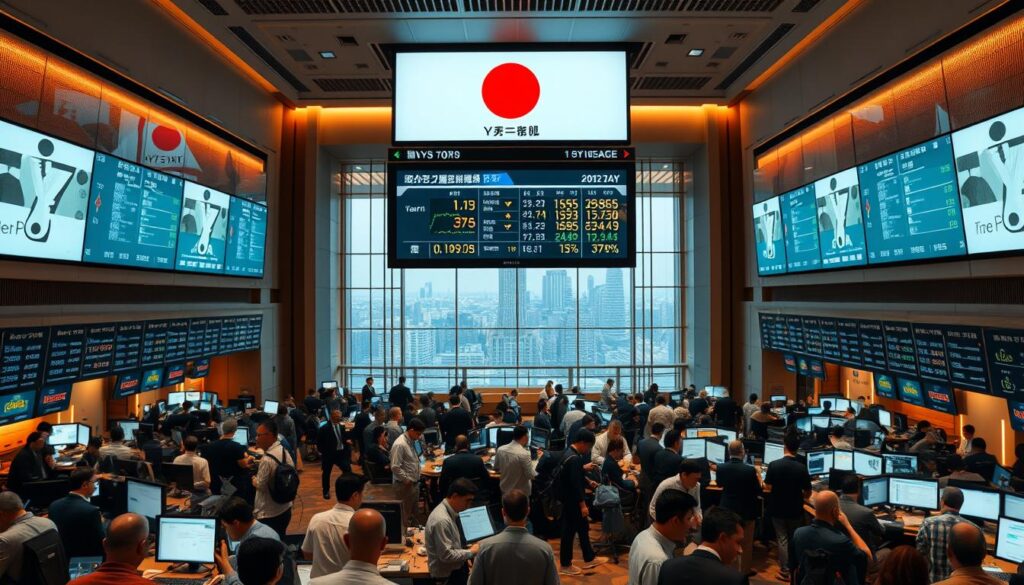Every second, over $7.5 trillion changes hands in the world’s largest financial arena – the foreign exchange market. This staggering figure dwarfs stock and commodity trades combined, making it the ultimate hub for international exchange activities.
While approximately 180 official monetary units exist globally, fewer than 10 account for nearly 75% of all transactions. These financial heavyweights act as economic barometers, reflecting national stability and influencing cross-border investments. Their constant movement shapes everything from holiday exchange rates to multinational corporate strategies.
Understanding these dominant monetary instruments isn’t just for bankers. Savvy travellers, online shoppers, and business owners all benefit from grasping how currency values impact purchasing power. The ripple effects of major trading pairs extend far beyond Wall Street, affecting household budgets and national economies alike.
This analysis breaks down the mechanisms driving global finance, revealing why certain monetary units maintain their stronghold. We’ll explore how geopolitical shifts and digital innovations are reshaping traditional market dynamics, creating new opportunities in an ever-evolving financial ecosystem.
Overview of the Global Forex Landscape
The foreign exchange arena has expanded dramatically since 2019, with daily activity now surpassing entire quarterly GDPs of mid-sized nations. This growth reflects both economic shifts and technological advancements in financial infrastructure.
Market Size and Daily Turnover
April 2022 saw forex market transactions hit $7.5 trillion daily – a 14% jump from 2019 figures. Foreign exchange swaps dominate this trading ecosystem, accounting for $3.8 trillion of daily volume. Immediate settlement deals (spot trades) follow at $2.1 trillion, often used for urgent international payments.
Key Participants in the Forex Market
Major international banks handle 51% of transactions through exclusive interbank networks. These institutions set benchmark rates that cascade through other market layers. Beyond this core group, three distinct tiers operate:
- Multinational corporations managing cross-border cash flows
- Asset managers hedging international portfolios
- Retail platforms serving individual traders
This hierarchy ensures constant liquidity, enabling seamless exchange across time zones. While electronic platforms now connect participants globally, pricing power remains concentrated among top-tier institutions.
The Role of Central Banks in Currency Trading

Central banks wield unprecedented influence over global financial currents through strategic maneuvers. Their decisions ripple across borders, affecting everything from currency valuations to import costs. Unlike private institutions, these financial authorities balance domestic stability with international market pressures.
Influence on Monetary Policy
Interest rate adjustments remain central banks’ primary tool for steering currency values. A 0.25% rate hike can trigger immediate shifts in market positions, as seen during recent Federal Reserve announcements. These institutions also shape expectations through forward guidance – carefully worded statements analyzed by traders worldwide.
Quantitative easing programs demonstrate another critical policy lever. By expanding balance sheets, central banks influence liquidity flows that directly impact exchange rates. However, prolonged interventions risk distorting natural market equilibriums.
Central Bank Reserve Strategies
Foreign exchange reserves act as shock absorbers during volatility spikes. The Bank of Japan’s $1.3 trillion reserve stockpile exemplifies this defensive strategy. Key intervention methods include:
- Direct currency purchases/sales in spot markets
- Coordinated actions with other central banks
- Swap line expansions for liquidity support
Critics argue such measures offer temporary relief at best. A 2022 IMF study revealed 58% of interventions failed to sustain desired currency levels beyond six months. Yet these efforts remain crucial for managing extreme market dislocations.
Analysis of the US Dollar’s Dominance

The Bretton Woods Agreement of 1944 cemented the greenback’s global position, tying international exchange rates to gold-backed dollars. This framework collapsed in 1971, but the currency retained its supremacy through America’s economic might and strategic alliances.
Historical Context and Economic Power
America’s post-war industrial boom created an unmatched production capacity. By 1960, the nation generated 40% of global GDP – a foundation for trade dominance. Three key factors sustain this status:
- Largest consumer market driving import/export flows
- Advanced financial infrastructure enabling seamless transactions
- Political stability attracting foreign capital
Over 60% of international invoices use dollars, even between non-US companies. This creates constant demand across exchange platforms worldwide.
The Dollar as the Global Reserve Currency
Central banks stockpile dollars to stabilize their economies during crises. The reserve status means:
- Lower borrowing costs for US government debt
- Automatic demand during market turbulence
- Pricing control for critical commodities
Oil markets exemplify this power – 80% of crude contracts use dollars. This “petrodollar” system compels nations to maintain dollar reserves, creating a self-perpetuating cycle of global reliance.
Impact of Economic Indicators on Currency Values

Financial markets react instantly to economic revelations, turning raw data into currency fluctuations within minutes. Over 80% of daily trading activity responds to scheduled reports and unexpected political developments. This constant information flow creates a dynamic where currencies become real-time report cards for national economies.
Key Economic Data Releases
Market-moving reports arrive like clockwork each month. Gross Domestic Product (GDP) figures show a country’s economic health, while employment data reveals workforce stability. Inflation numbers – particularly consumer prices – directly influence central bank decisions. Three critical metrics dominate trader dashboards:
- Unemployment rate changes
- Manufacturing output indices
- Retail sales growth
Surprises in these reports can shift exchange rates by 1-2% within hours. The 2022 Eurozone inflation shock demonstrated this, causing 3% swings in EUR/USD trading pairs overnight.
Monetary Policies and Interest Rates
Central bank meetings serve as quarterly checkpoints for currency markets. When the Federal Reserve raised rates by 0.75% in 2022, the dollar gained 7% against major peers within weeks. Key policy tools include:
- Benchmark interest rate adjustments
- Quantitative easing programs
- Forward guidance language
Interest differentials create currency flows – investors chase higher yields, boosting demand for stronger-rate currencies. Political events like elections amplify these effects, as seen when the British pound lost 9% post-2016 Brexit vote.
An In-Depth Look at the most traded currencies

Global finance revolves around a handful of monetary units that dominate transaction flows. One heavyweight appears in nearly 9 out of 10 forex deals, creating constant demand across time zones. This concentration shapes pricing efficiency and liquidity for all market participants.
Trading Volume Insights
Daily transaction patterns reveal stark contrasts between top performers. The leader commands 88% participation across currency pairs, while its closest competitor handles 30% of deals. Three factors drive this disparity:
- Reserve status in central bank holdings
- Commodity pricing conventions
- Settlement infrastructure efficiency
High turnover translates to tighter spreads – often below 0.5 pips for major pairs. This attracts both algorithmic traders and multinational corporations managing cash flows.
Market Trends and Volatility
Geopolitical shifts create predictable patterns in currency movements. Emerging market crises typically boost safe-haven flows by 15-20%. Seasonal influences include:
- Quarter-end portfolio rebalancing
- Holiday-related liquidity drops
- Central bank reporting cycles
Electronic trading platforms amplify reactions to news events, sometimes tripling normal volatility. However, institutional players often stabilize prices through large-scale arbitrage operations.
Insights into the Euro as a Global Currency

Since its 1999 launch, the euro has become the linchpin of Europe’s financial architecture. With 346 million users across 19 nations, it facilitates trade across borders equivalent to 14% of global GDP. This unified monetary system eliminates exchange rate risks for member countries, creating seamless commercial networks.
Influence of the Eurozone Economy
The European Central Bank’s policies reverberate through global markets. Recent quantitative easing programs moved EUR/USD rates by 3% within hours of announcement. Three structural advantages maintain demand:
- Integrated payment systems handling €2.1 trillion daily
- Consistent current account surpluses since 2012
- Diverse industrial and service export base
Reserve Currency Status and Trade Impact
Central banks hold €2.8 trillion in euro reserves – a hedge against dollar dominance. This reserve role enables:
- Lower borrowing costs for EU institutions
- Pricing stability in energy contracts
- Reduced volatility during trading shocks
However, political fragmentation risks persist. The 2022 energy crisis saw temporary capital outflows before ECB interventions stabilized exchange rates. As digital payment systems evolve, the euro’s role in international settlements keeps expanding.
The Significance of the Japanese Yen in International Markets

Third in global reserves, the yen’s influence extends far beyond Japan’s shores. Handling $554 billion daily, this currency serves as Asia’s primary medium for regional exchange and cross-border investments. Its stability attracts central banks and corporations alike, despite Japan’s lack of natural resources.
Economic Performance and Manufacturing Exports
Japan’s export-driven economy fuels demand for its currency. The nation supplies 15% of global vehicles and 20% of industrial robots, creating consistent foreign exchange inflows. Key export pillars include:
- Precision machinery components
- Semiconductor manufacturing equipment
- Automotive technology systems
Bank of Japan interventions often counterbalance trading volatility caused by energy price swings. Recent manufacturing slumps – particularly in electronics – have tested the yen’s resilience against dollar dominance.
Reserve Currency Features
Comprising 4.9% of global reserves, the yen offers diversification from Western monetary units. Three factors sustain its reserve status:
- Deep liquidity in Asian exchange markets
- Low inflation history spanning decades
- Safe-haven demand during geopolitical crises
Japan’s energy import needs create unique pressures. A $10 oil price increase typically weakens the currency by 1.5% against commodity-linked rivals. Yet institutional investors maintain substantial yen holdings for portfolio balance in turbulent markets.
Evaluating the British Pound’s Performance Post-Brexit
The pound sterling lost 15% of its value within weeks of the 2016 Brexit vote – the sharpest decline among major global currencies. This shockwave revealed how political decisions can reshape financial landscapes overnight. Today, sterling handles $422 billion in daily transactions, maintaining its position as a heavyweight in international markets despite ongoing challenges.
Economic and Political Factors
Brexit fundamentally altered the UK’s trade dynamics with its largest partner – the European Union. Customs delays and regulatory hurdles reduced bilateral goods flows by 14% since 2020. Three critical factors now drive pound currency valuations:
- Service sector performance (80% of UK GDP)
- Bank of England’s inflation management
- Ongoing EU relationship negotiations
Central banks worldwide hold 4.5% of reserves in sterling – a trust metric that dropped 1.2% post-Brexit. The exchange rate rollercoaster continues, with 10% swings occurring twice annually since 2020. Investors demand higher premiums for UK government debt compared to pre-2016 levels.
Recent trade deals with Pacific nations aim to offset European losses, but their financial impact remains limited. The pound’s role in global exchange systems now depends on London maintaining its financial hub status. As digital payment networks evolve, sterling faces competition from alternative settlement currencies.
Australian and Canadian Dollars – Commodity and Trade Influences
Natural resource wealth directly fuels the value of two leading monetary units from opposite hemispheres. The Australian dollar and Canadian dollar collectively process $389 billion daily, their fortunes tied to global demand for raw materials.
Impact of Commodity Prices
Iron ore shipments drive 22% of Australia’s export income, making its currency sensitive to Chinese infrastructure projects. Canada’s energy sector contributes 10% to national GDP, linking oil prices to exchange rate movements. Key export drivers include:
- Australia: Coal (15% of exports), copper (6%)
- Canada: Crude oil (18%), natural gas (5%)
A 10% swing in metal prices typically moves the AUD by 1.3% against the USD. For Canada, every $5 change in oil costs alters the CAD/USD rate by 1%.
Trade Relationships with Key Partners
Geography shapes these countries‘ economic alliances. Canada sends 75% of exports to the US, creating tight monetary policy alignment. Australia relies on China for 38% of overseas sales, exposing its currency to Asian market shifts.
Three factors maintain their reserve status:
- Stable political environments attracting foreign investment
- Diversified resource portfolios reducing single-commodity risk
- High-interest rate differentials during commodity booms
Recent trade pacts like the CPTPP strengthen Australia’s Asian ties, while Canada’s USMCA agreement stabilizes North American trade flows. Both countries balance resource dependence through technology and service exports.
Swiss Franc: The Safe-Haven Currency for Uncertain Times
Switzerland’s financial fortress status makes its currency a global safe harbor. The Swiss franc handles $164 billion daily in exchange activities, ranking seventh worldwide. Its 0.18% share of global reserves reflects unique demand patterns shaped by geopolitical turbulence.
Banking Secrecy and Financial Stability
Swiss banks maintain centuries-old traditions of discretion and asset protection. Three pillars underpin the franc’s strength:
- Government debt below 30% of GDP
- Negative interest rate policies since 2015
- Gold reserves covering 5% of money supply
This combination creates stability when other markets falter. During the 2020 pandemic, the franc gained 4% against the euro as investors sought shelter.
International Demand During Market Stress
Crisis periods see trading volumes spike 25% for CHF pairs. The currency’s 2022 performance against the dollar (+8%) highlights its hedge value. Exporters face challenges when franc strength raises exchange rates, but Switzerland’s trade surplus cushions these impacts.
Global markets treat the franc as financial insurance – a status sustained by Switzerland’s neutral politics and AAA credit rating. As digital payment systems grow, this currency retains its appeal through predictable performance in volatile times.



